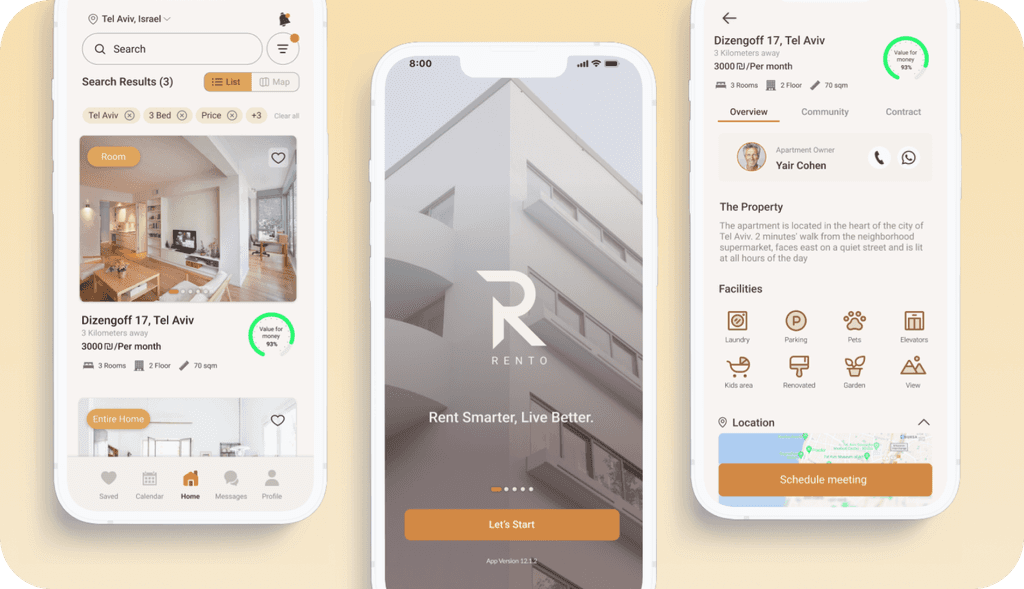Rento
Type
Independent student project
My Role
Entire product design from research to conception and visualization
Timeline
February - May 2024
Understanding the Problem
Rento is a centralized platform designed to simplify and optimize the process of finding and renting apartments. By streamlining the search and rental procedures, it aims to make the experience less exhausting and more efficient for both landlords and tenants. While Rento isn’t a solution to the housing crisis in Tel Aviv, it provides a valuable tool to facilitate and improve the way apartments are rented and managed.
User interviews
To better understand the challenges faced by potential users of our platform, I conducted a series of interviews with both apartment owners and tenants. The primary objective was to uncover the difficulties they encounter with existing rental platforms and to determine their ideal expectations when searching for apartments or tenants.
Key Findings
Both tenants and landlords often find the communication process cumbersome and inefficient on current platforms.
Users expressed frustration over the lack of detailed and accurate descriptions in apartment listings.
Scheduling viewings was identified as a major pain point, with users seeking a more streamlined approach.
There's a desire for greater transparency regarding the conditions of the apartment and the reliability of tenants or landlords..
Users are looking for intuitive features that can personalize and simplify their search or listing process.
The existing platforms do not necessarily meet the need to find an apartment in an orderly manner.
Personas
I created a user personas that represent our target audience’s needs and behaviors. This part helps us tailor our design to address real user challenges effectively.
Competitive Analysis
In my competitor analysis, I used the SWOT model to assess each competitor's strengths, weaknesses, opportunities, and threats. This model helps identify internal advantages and disadvantages (Strengths and Weaknesses) as well as external factors that can impact the project positively or negatively (Opportunities and Threats).
Concept Development
In our brainstorming session, we explored two main concepts for our app: the Feed and Tinder concepts. The Feed concept features a traditional, scrollable list of apartment listings for easy comparison. The Tinder concept provides an interactive swiping mechanism to express interest in listings. Following user testing, we selected the Feed concept for its enhanced usability and alignment with user preferences. More details on this testing will be provided in subsequent sections.
Information Architecture
I designed an information architecture that is both easy to use and clear, allowing users to navigate the app efficiently and effectively, thereby enhancing the user experience.
Wireframes
Employing low-fidelity paper prototypes derived from comprehensive competitor research, questionnaire insights, and the two prioritized user flows, I manually crafted a preliminary structure for the platform..
User Testing
Following our user testing, the Feed concept received more positive feedback compared to the Tinder-style interface. We presented participants with low-fidelity versions of both designs, and the Feed concept was found to be more intuitive and clearer to use. This feedback played a crucial role in our decision to proceed with the Feed concept as the primary design for our application
Final Design

Navigating Views and Applying Filters
Enabled switching between list and map views to enhance apartment search functionality. I also show how I implemented user-friendly filters to help narrow down search options efficiently.

Filtering and Economic Analysis Tools
Here, I present the refined search results following the application of filters, which are always visible for easy adjustments. I included a 'Value for Money' feature, which displays a historical price trend graph when activated, and detailed apartment views that facilitate scheduling a visit or exploring more about the property.

I illustrated the community aspect of the platform, showing how users can see and connect with other interested tenants. I also highlight how users can compare apartments directly from their saved listings. Finally, I show the personal schedule feature, where users can manage their viewing appointments and potential roommate meetings.
Takeaways
Develop Landlord Interface
Enhance the interface for landlords to include more comprehensive management tools such as tracking tenant applications and receiving notifications for key actions.
Expand User Onboarding
Improve the onboarding process to educate new users about the unique features of the platform, ensuring they can fully leverage all available tools from the start.
Enhance Mobile Experience
Given the positive feedback on the platform's usability, further optimize the mobile experience to ensure accessibility and convenience for users on-the-go.








